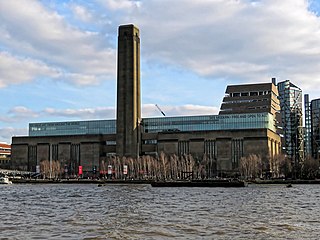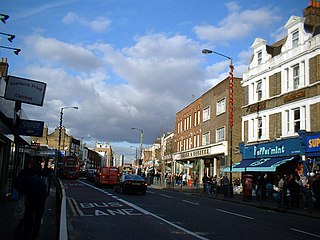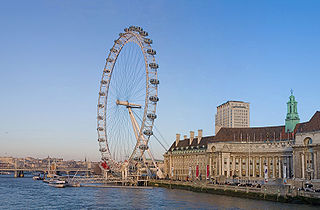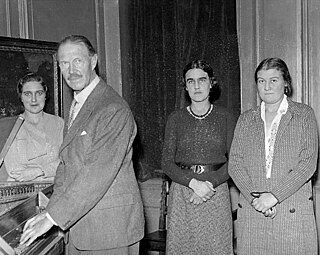
Tate Modern is an art gallery located in London. It houses the United Kingdom's national collection of international modern and contemporary art, and forms part of the Tate group together with Tate Britain, Tate Liverpool and Tate St Ives. It is located in the former Bankside Power Station, in the Bankside area of the London Borough of Southwark.

The London Borough of Southwark in south London forms part of Inner London and is connected by bridges across the River Thames to the City of London and London Borough of Tower Hamlets. It was created in 1965 when three smaller council areas amalgamated under the London Government Act 1963. All districts of the area are within the London postal district. It is governed by Southwark London Borough Council.

Walworth is a district of south London, England, within the London Borough of Southwark. It adjoins Camberwell to the south and Elephant and Castle to the north, and is 1.9 miles (3.1 km) south-east of Charing Cross.

The National Trust for Places of Historic Interest or Natural Beauty, commonly known as the National Trust, is a charity and membership organisation for heritage conservation in England, Wales and Northern Ireland. In Scotland, there is a separate and independent National Trust for Scotland.

South Bank is an entertainment and commercial district in central London, next to the River Thames opposite the City of Westminster. It forms a narrow strip of riverside land within the London Borough of Lambeth and the London Borough of Southwark,. As such, South Bank may be regarded as somewhat akin to the riverside part of an area known previously as Lambeth Marsh and North Lambeth.

Bankside is a district of London, England, and part of the London Borough of Southwark. Bankside is located on the southern bank of the River Thames, 1.5 miles (2.4 km) east of Charing Cross, running from a little west of Blackfriars Bridge to just a short distance before London Bridge at St Mary Overie Dock to the east which marks its distinct status from that of 'the Borough' district of Southwark. It is part of a business improvement district known as Better Bankside.

Burgess Park is a public park situated in the London Borough of Southwark, in an area between Camberwell to the west, Walworth to the north, Bermondsey to the east and Peckham to the south. At 56 hectares, it is one of the largest parks in South London.

Octavia Hill was an English social reformer, whose main concern was the welfare of the inhabitants of cities, especially London, in the second half of the nineteenth century. Born into a family with a strong commitment to alleviating poverty, she herself grew up in straitened circumstances owing to the financial failure of her father's businesses. With no formal schooling, she worked from the age of 14 for the welfare of working people.

The London Borough of Southwark, occupying a roughly triangular area south of Tower Bridge over the River Thames, considers itself to be one of the greenest boroughs in London, with its 245 hectares of public parkland. There are more than 130 such green areas, ranging from the large areas around Dulwich and Southwark Park in Rotherhithe to the many sports grounds and squares. The main ones are:

Stamford Street is a street in Lambeth and Southwark, London, England, just south of the River Thames. It runs between Waterloo Road to the west and Blackfriars Road to the east. It forms part of the A3200.
Bankside Open Spaces Trust (BOST) is a horticulture, gardening and management of urban open space charity, based in Bankside, the southern bank by the River Thames, Southwark, Central London, England. BOST services clients in London and supports and inspires people of local communities and organisations, among others Tate Modern community garden, to improve, create and enjoy the parks, gardens, green spaces, and, passive and active recreation areas.

Cross Bones is a disused post-medieval burial ground on Redcross Way in Southwark, south London. Up to 15,000 people are believed to have been buried there. It was closed in 1853.

Major George Henry Benton Fletcher was a collector of early keyboard instruments including virginals, clavichords, harpsichords, spinets and early pianos. His collection is currently housed and kept in playing condition by the National Trust in Fenton House, a beautiful late 17th century merchant's house in, Hampstead, north London.

Christ Church, Southwark, is a church of the Anglican denomination situated on the west side of Blackfriars Road, London. At the time of the foundation there was no bridge at Blackfriars and so no major road connecting the area to the south or to the City.
Gainsborough Gardens is a private road in Hampstead, in the London Borough of Camden. The road is arranged in an oval crescent around a central garden. It was laid out on land that belonged to the Wells and Campden Charity Trust overseen by H.S. Legg, the surveyor of the trust between 1882 and 1895. The creation and aesthetics of Gainsborough Gardens was influenced by the Bedford Park development in Chiswick. The communal garden at the centre of the development is 0.4137 hectares in size and was the site of a bowling green and ornamental pond in former pleasure gardens.
Emily Anne Peasgood is an Ivors Composer Awards winning English composer and sound artist. She is the niece of actress and television presenter Julie Peasgood.
The Metropolitan Public Gardens Association is a charity in London for the purposes of the preservation of public parks and gardens, established in 1882. It facilitated the creation of new public open spaces, including from philanthropic landowners within its membership. The MPGA was involved in the formation and development of other amenity organisations. The charity still exists; in recent decades its emphasis has changed to smaller parcels of land and smaller projects within larger spaces, as well as to themed projects. The MPGA was the starting point for the careers of the ground-breaking female landscape gardeners Fanny Wilkinson and Madeline Agar.
Archbishop's Park is a 3.93 hectares park in Lambeth in the London Borough of Lambeth in London, England, which opened to the public in 1901. Before it became a park, it formed part of the grounds of Lambeth Palace.
Elijah Hoole was an English architect of Methodist churches, settlement halls and social housing. In relation to the social housing, he worked closely with the social reformer Octavia Hill for over 40 years.



















